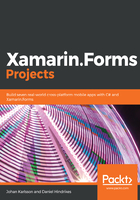
上QQ阅读APP看书,第一时间看更新
Conventions used
There are a number of text conventions used throughout this book.
CodeInText: Indicates code words in text, database table names, folder names, filenames, file extensions, pathnames, dummy URLs, user input, and Twitter handles. Here is an example: "Open the DescriptionGenerator.cs file and add a constructor, as shown in the following code."
A block of code is set as follows:
public class DescriptionGenerator
{
private string[] _adjectives = { "nice", "horrible", "great",
"terribly old", "brand new" };
private string[] _other = { "picture of grandpa", "car", "photo
of a forest", "duck" };
private static Random random = new Random();
public string Generate()
{
var a = _adjectives[random.Next(_adjectives.Count())];
var b = _other[random.Next(_other.Count())];
return $"A {a} {b}";
}
}
When we wish to draw your attention to a particular part of a code block, the relevant lines or items are set in bold:
{
TabLayoutResource = Resource.Layout.Tabbar;
ToolbarResource = Resource.Layout.Toolbar;
base.OnCreate(savedInstanceState);
global::Xamarin.Forms.Forms.Init(this, savedInstanceState);
Xamarin.Essentials.Platform.Init(this, savedInstanceState);
LoadApplication(new App());
}
Bold: Indicates a new term, an important word, or words that you see onscreen. For example, words in menus or dialog boxes appear in the text like this. Here is an example: "Select System info from the Administration panel."
Warnings or important notes appear like this.
Tips and tricks appear like this.